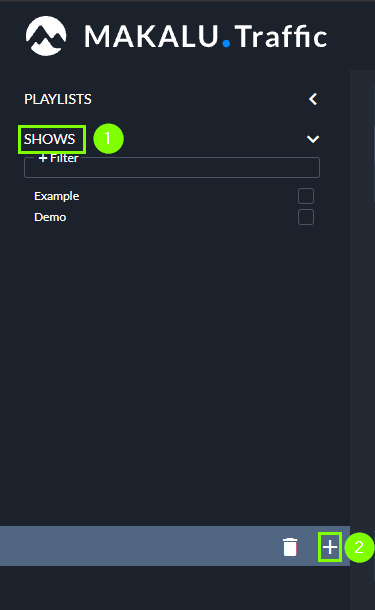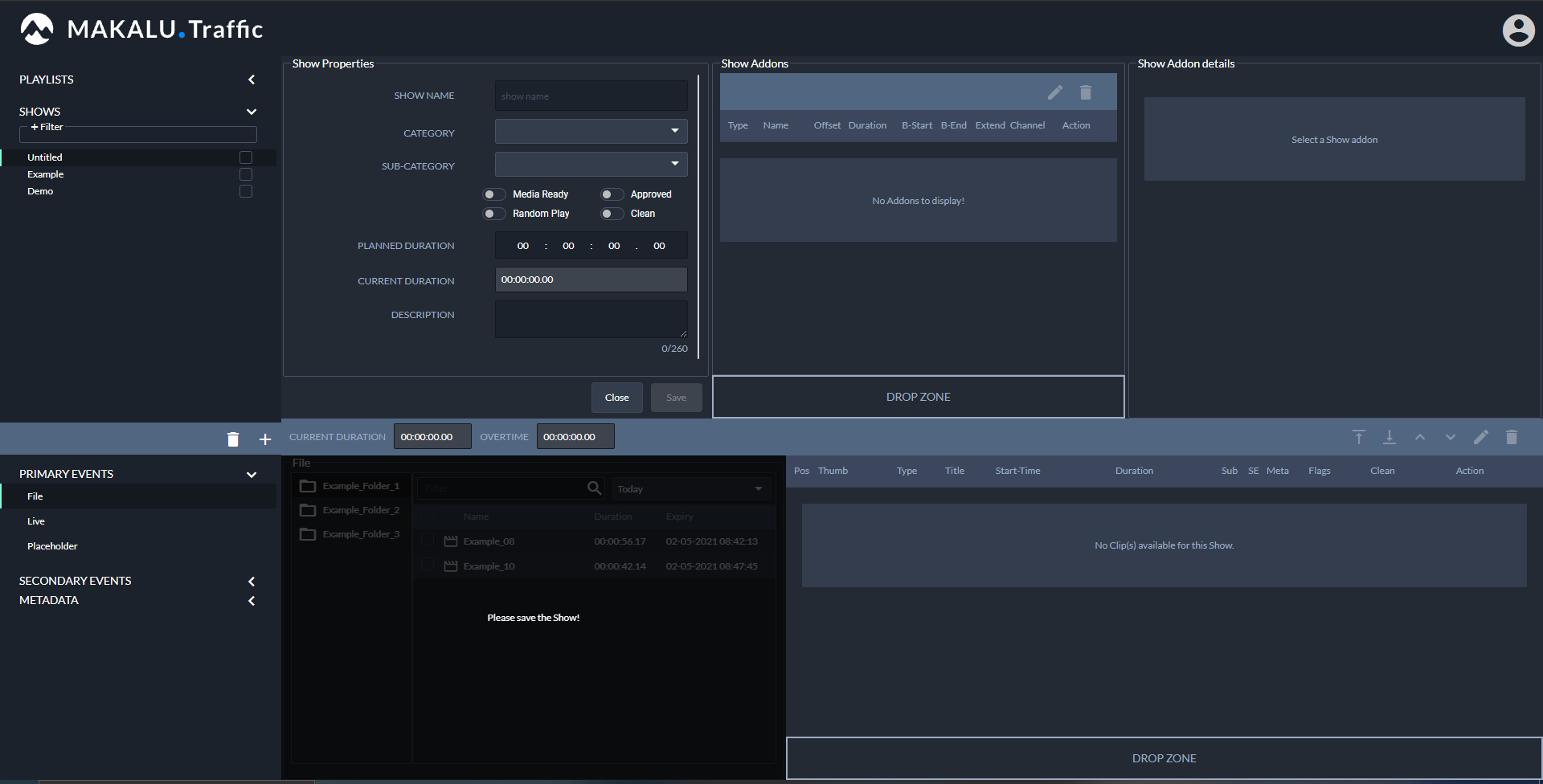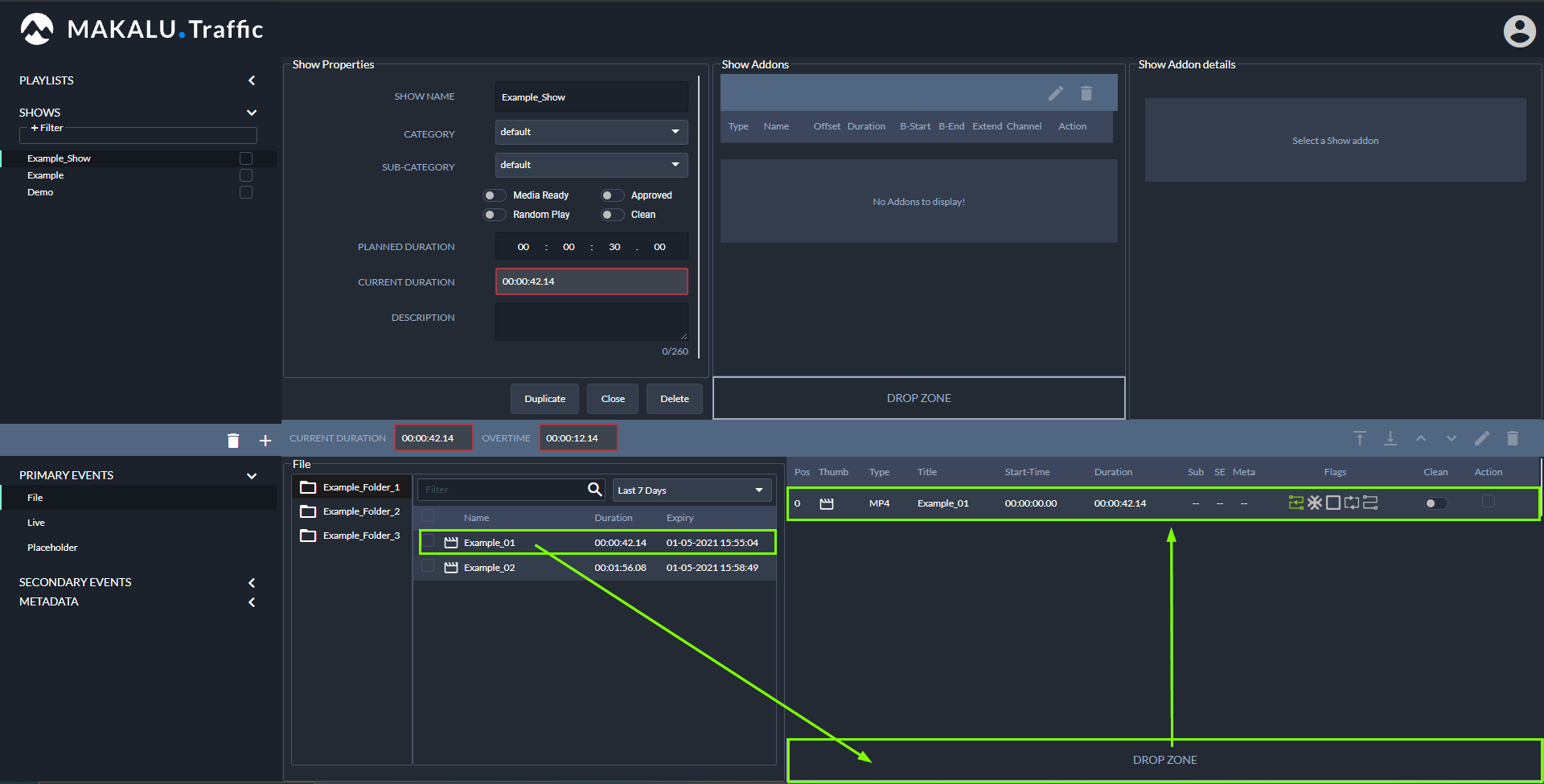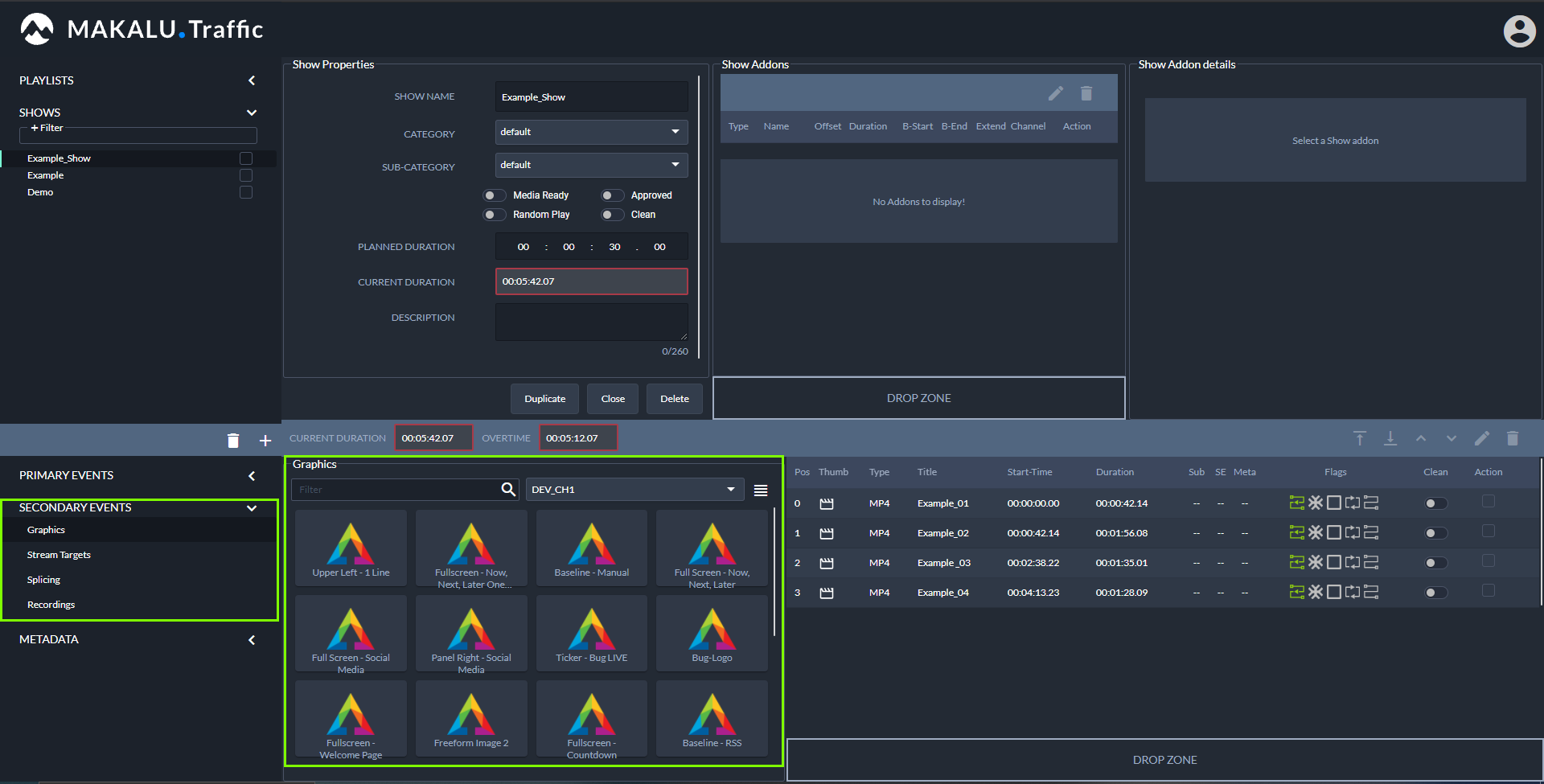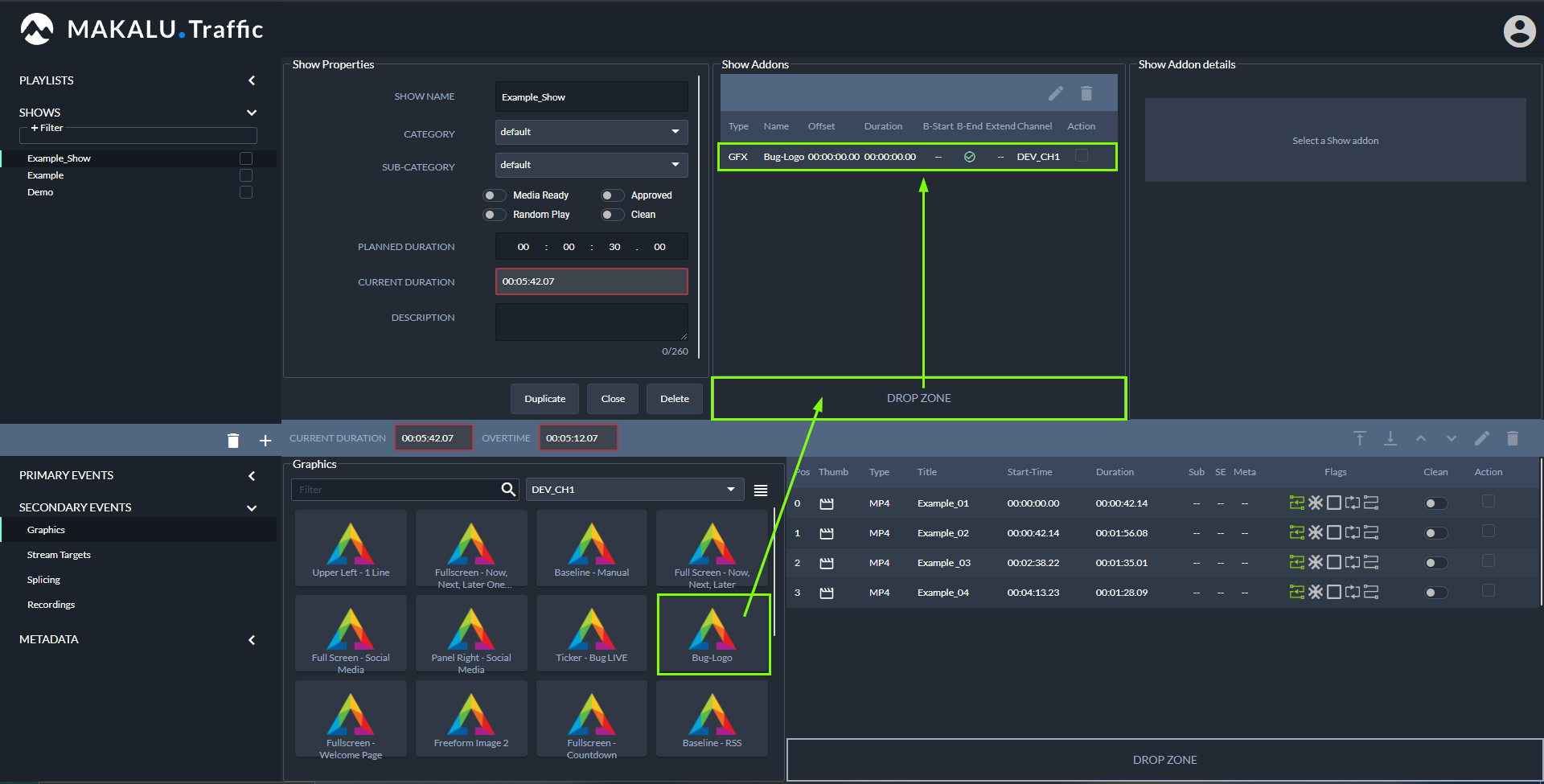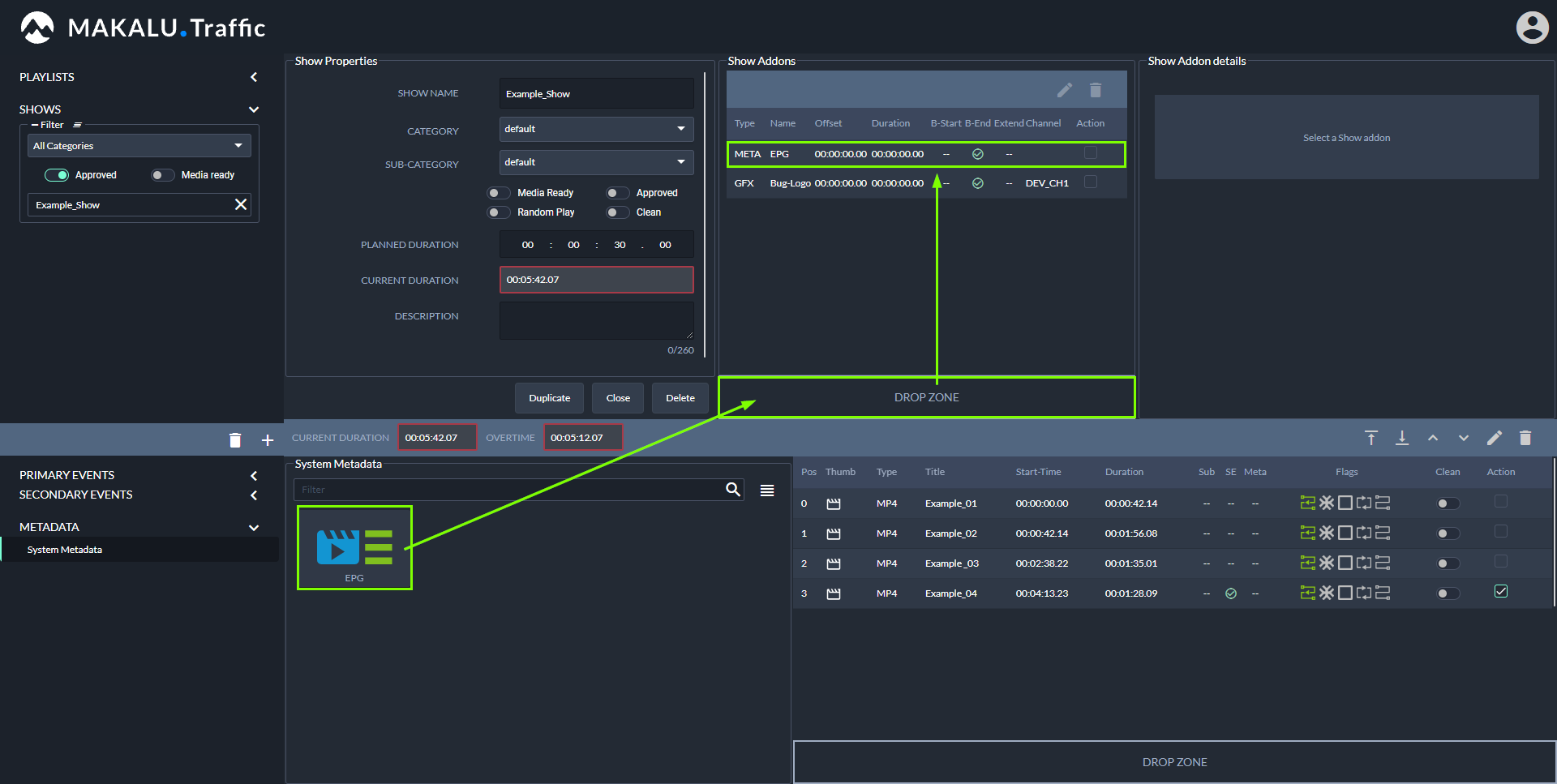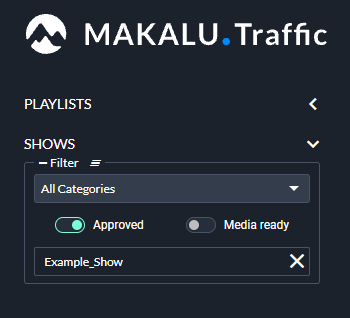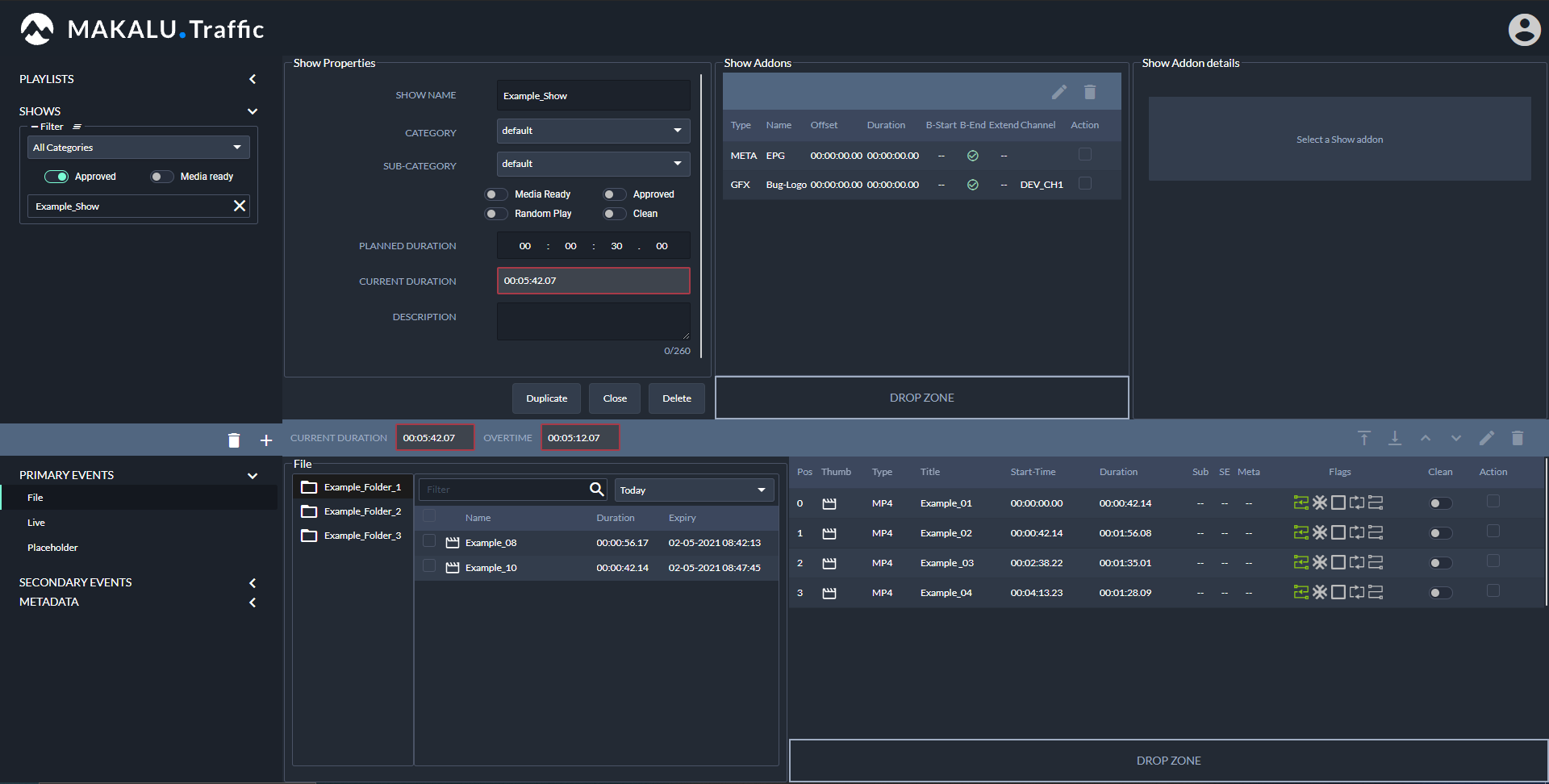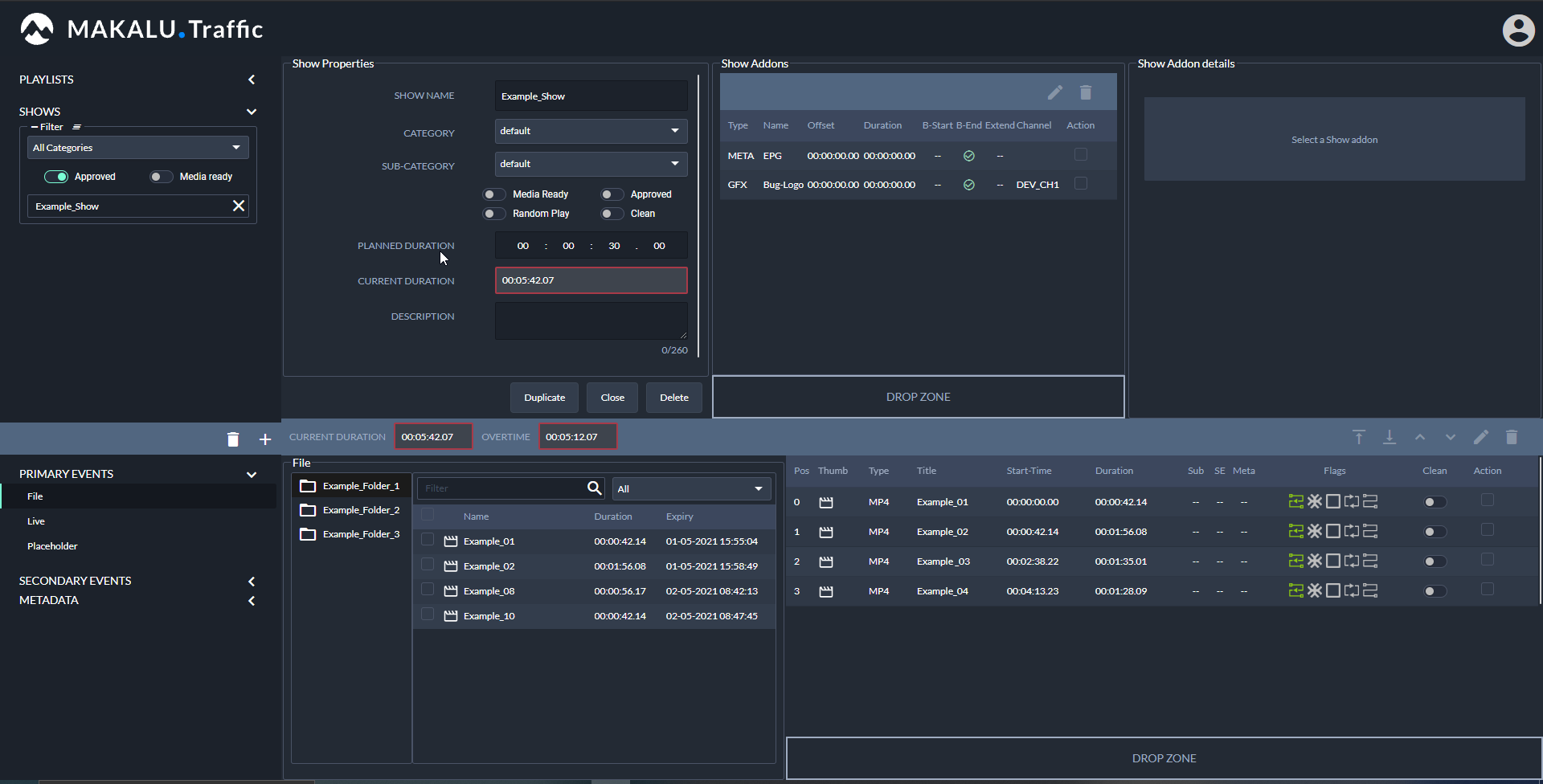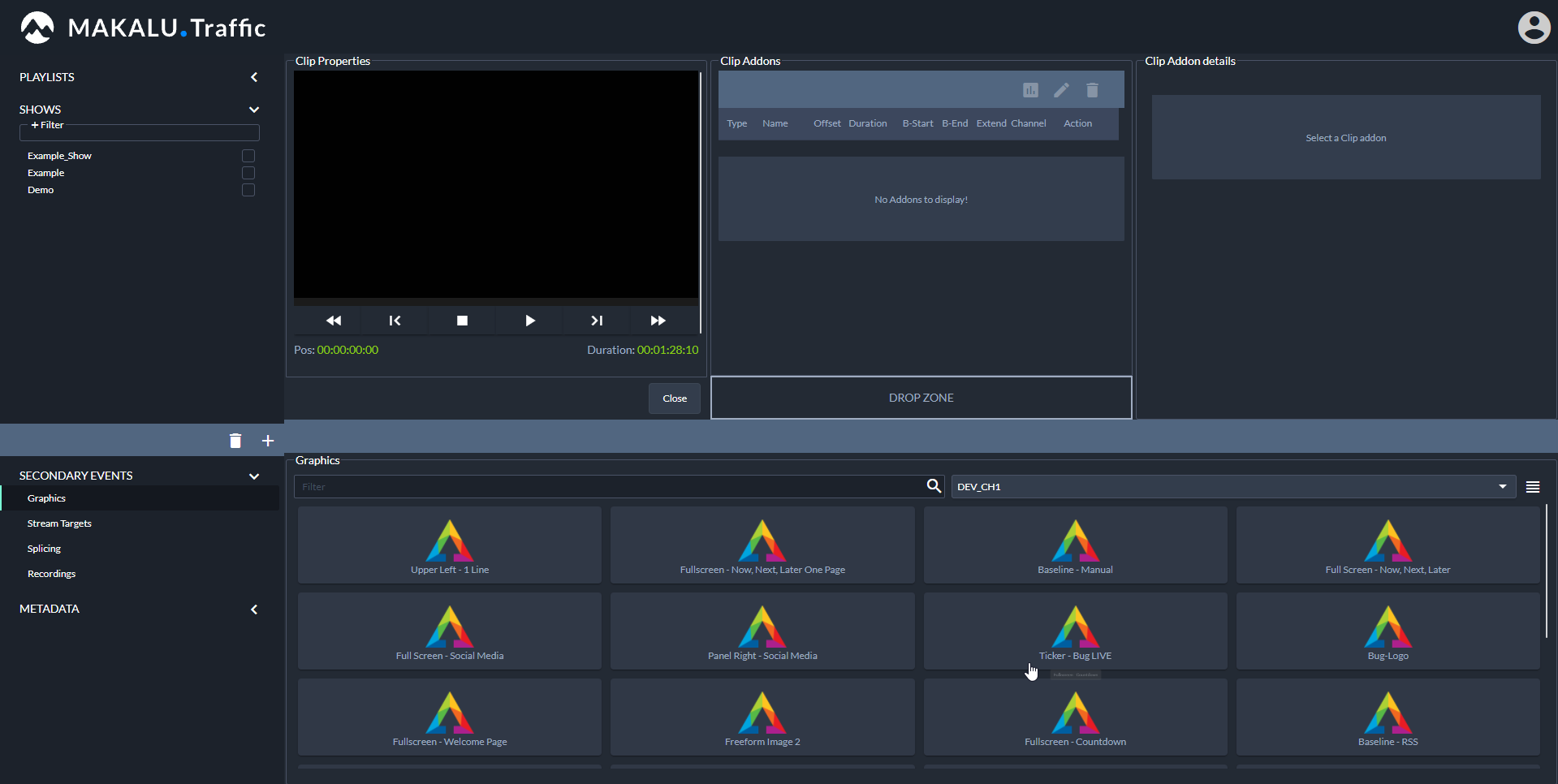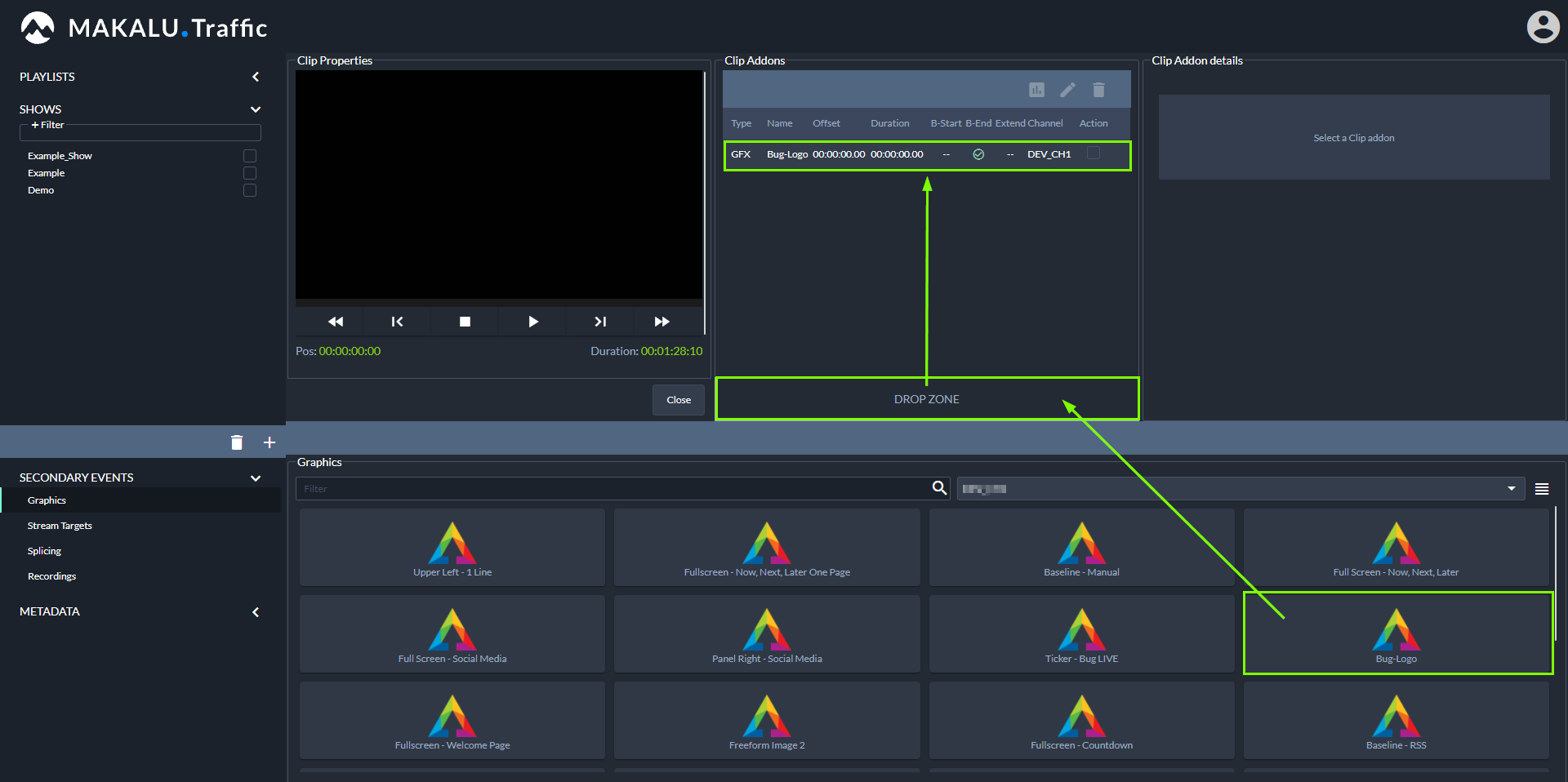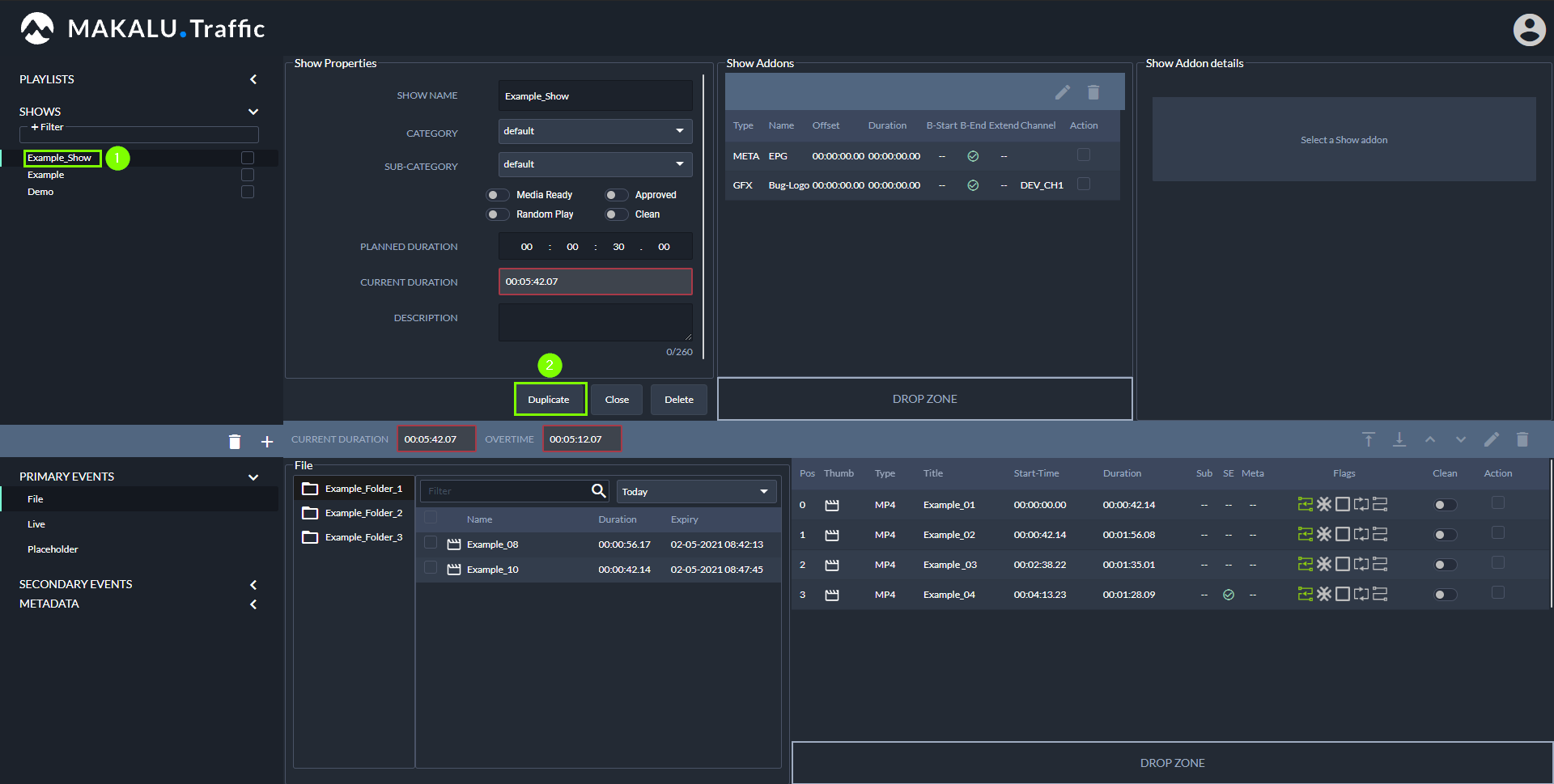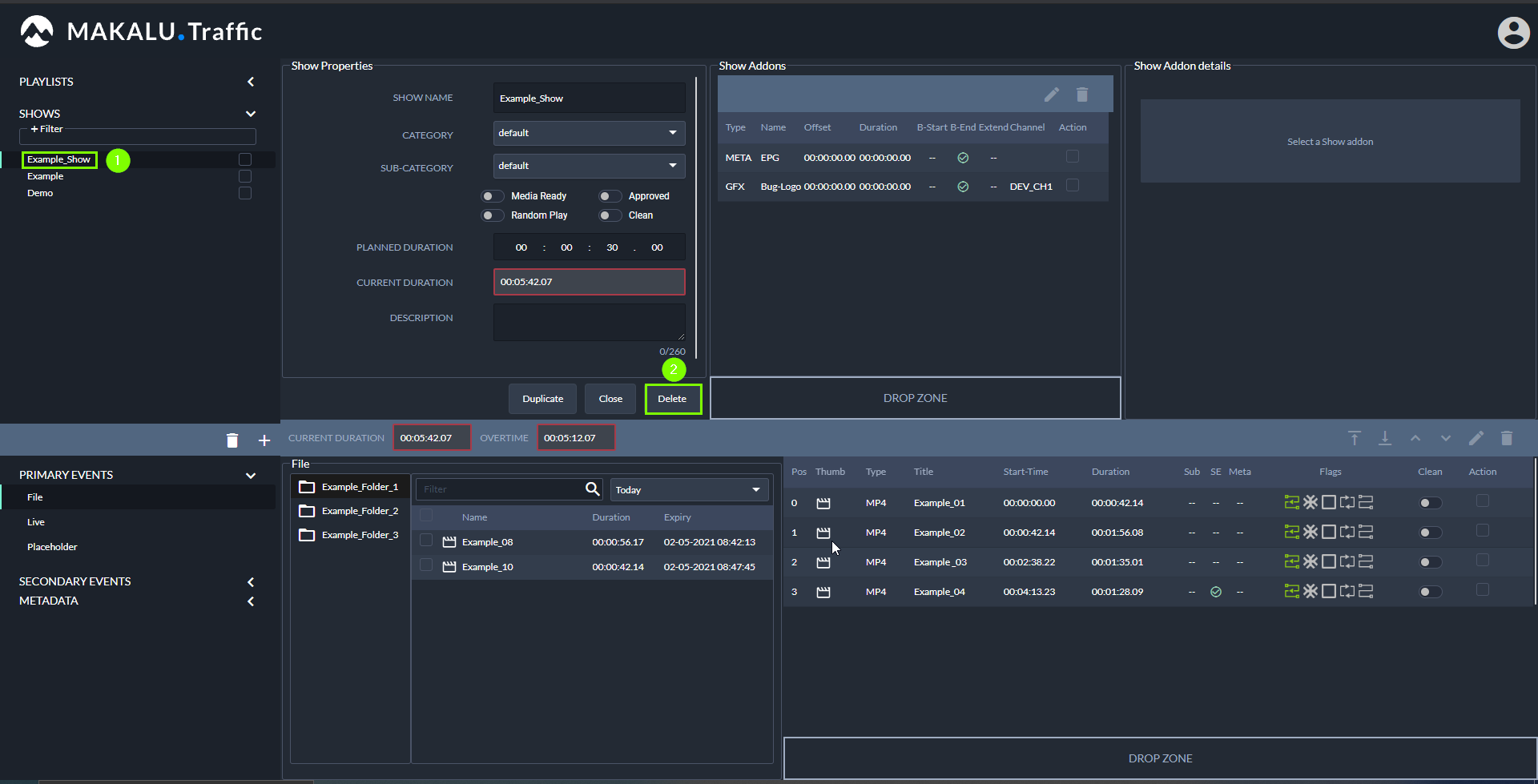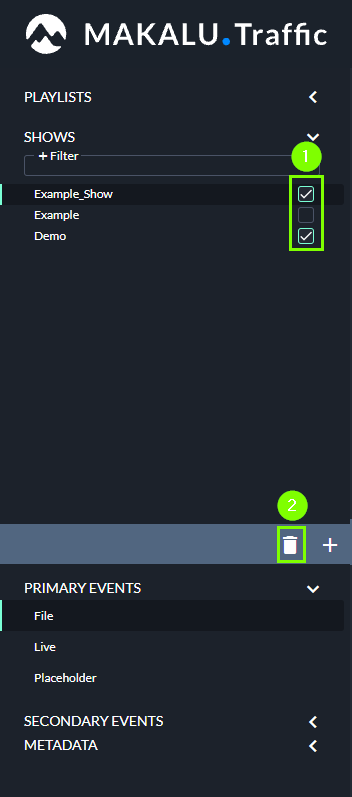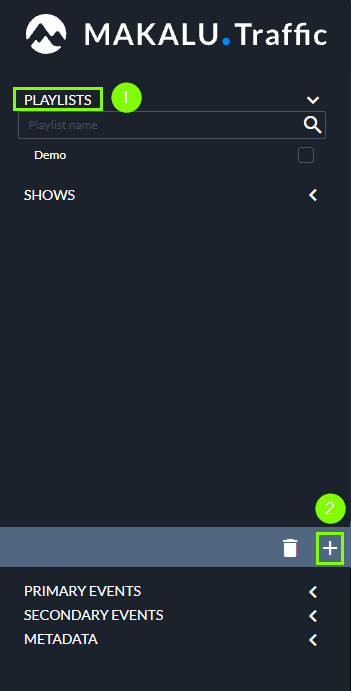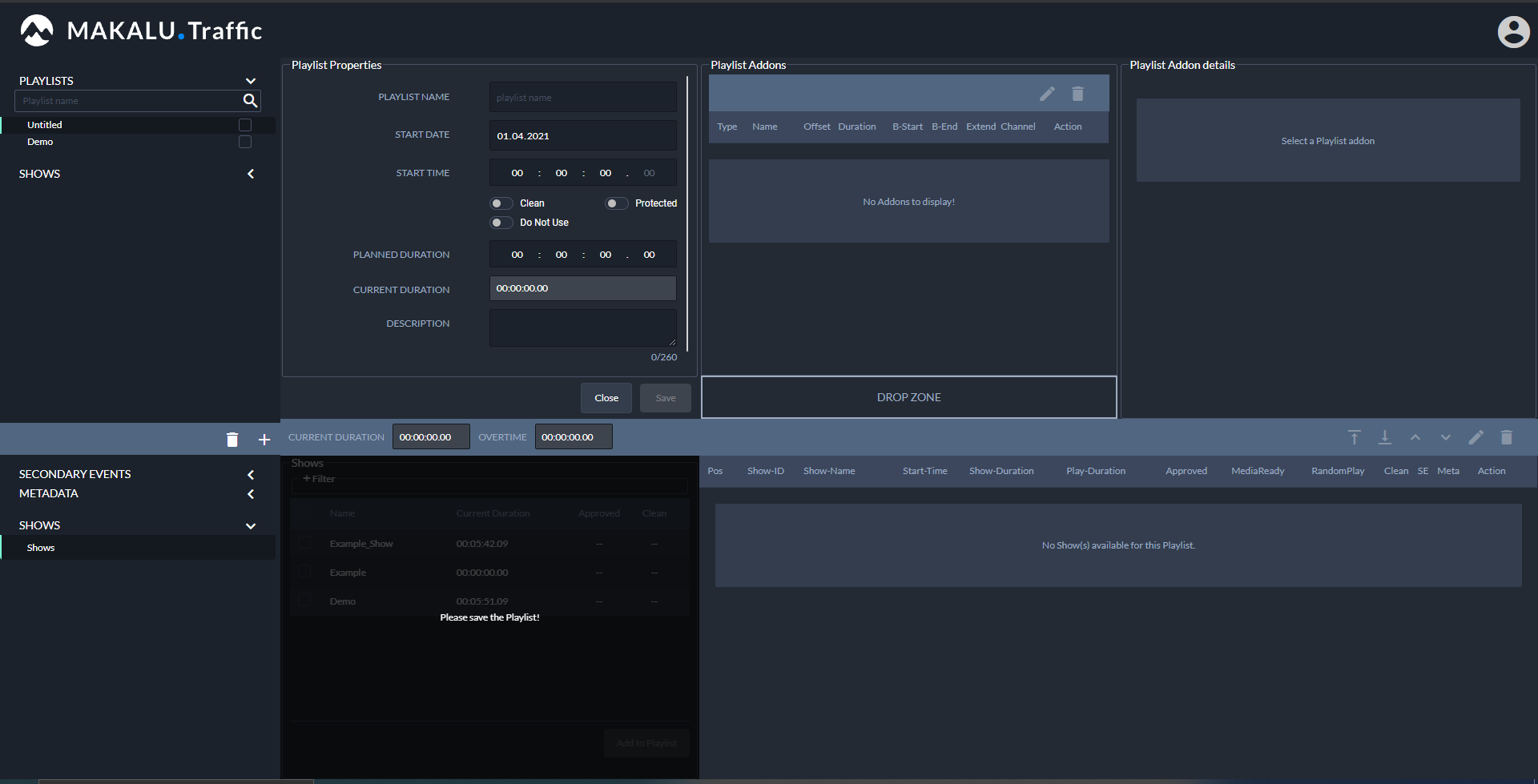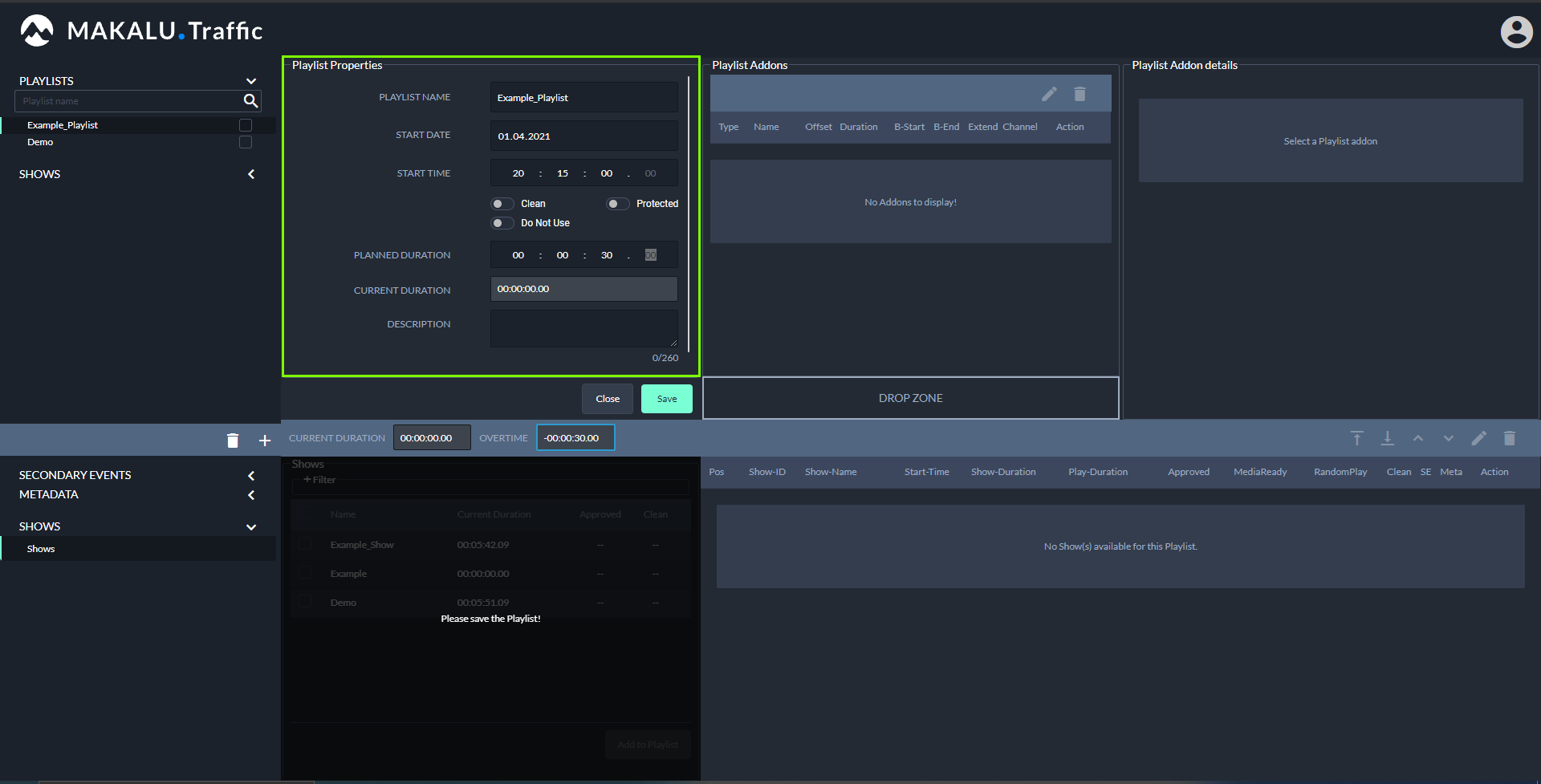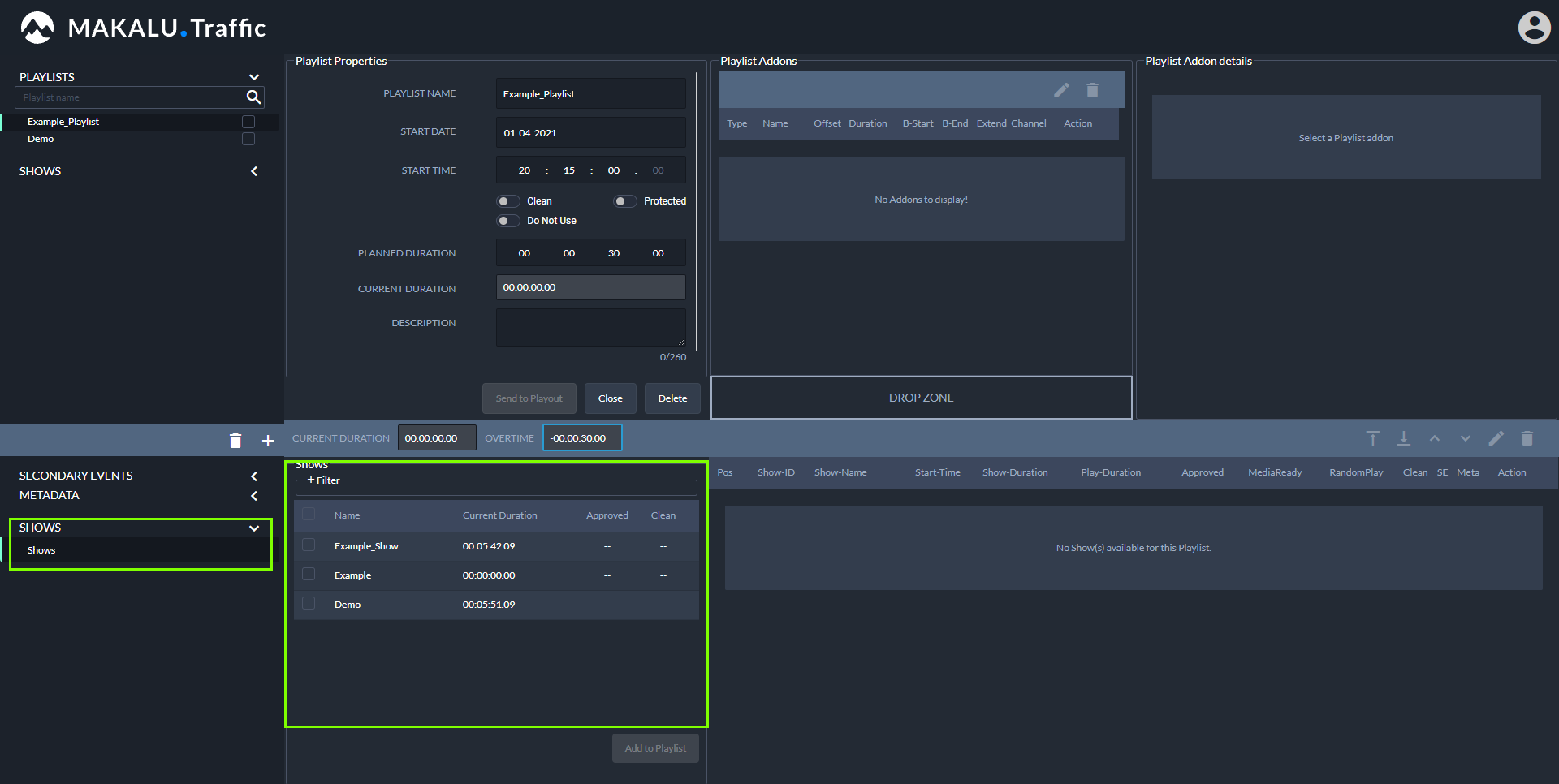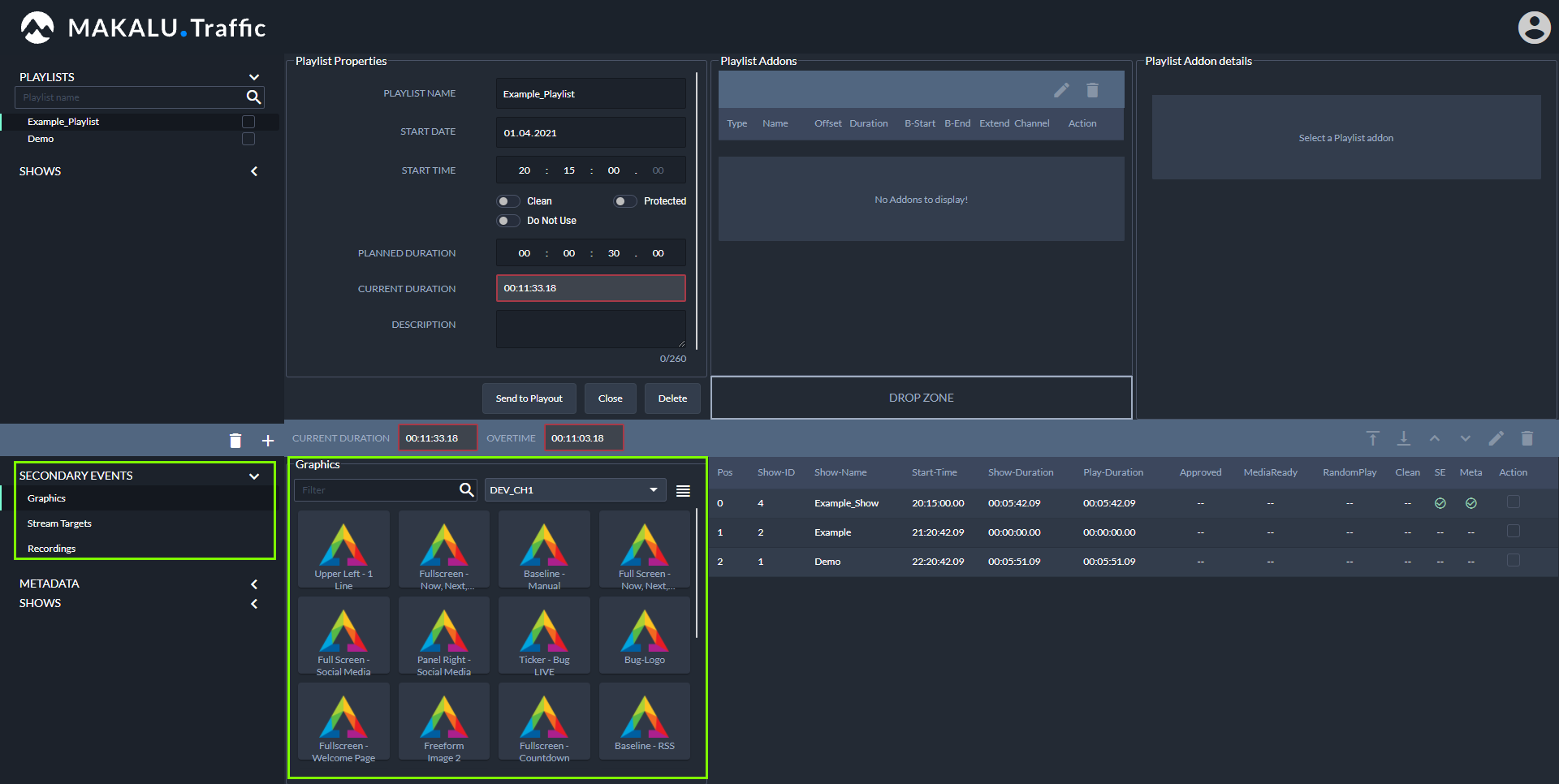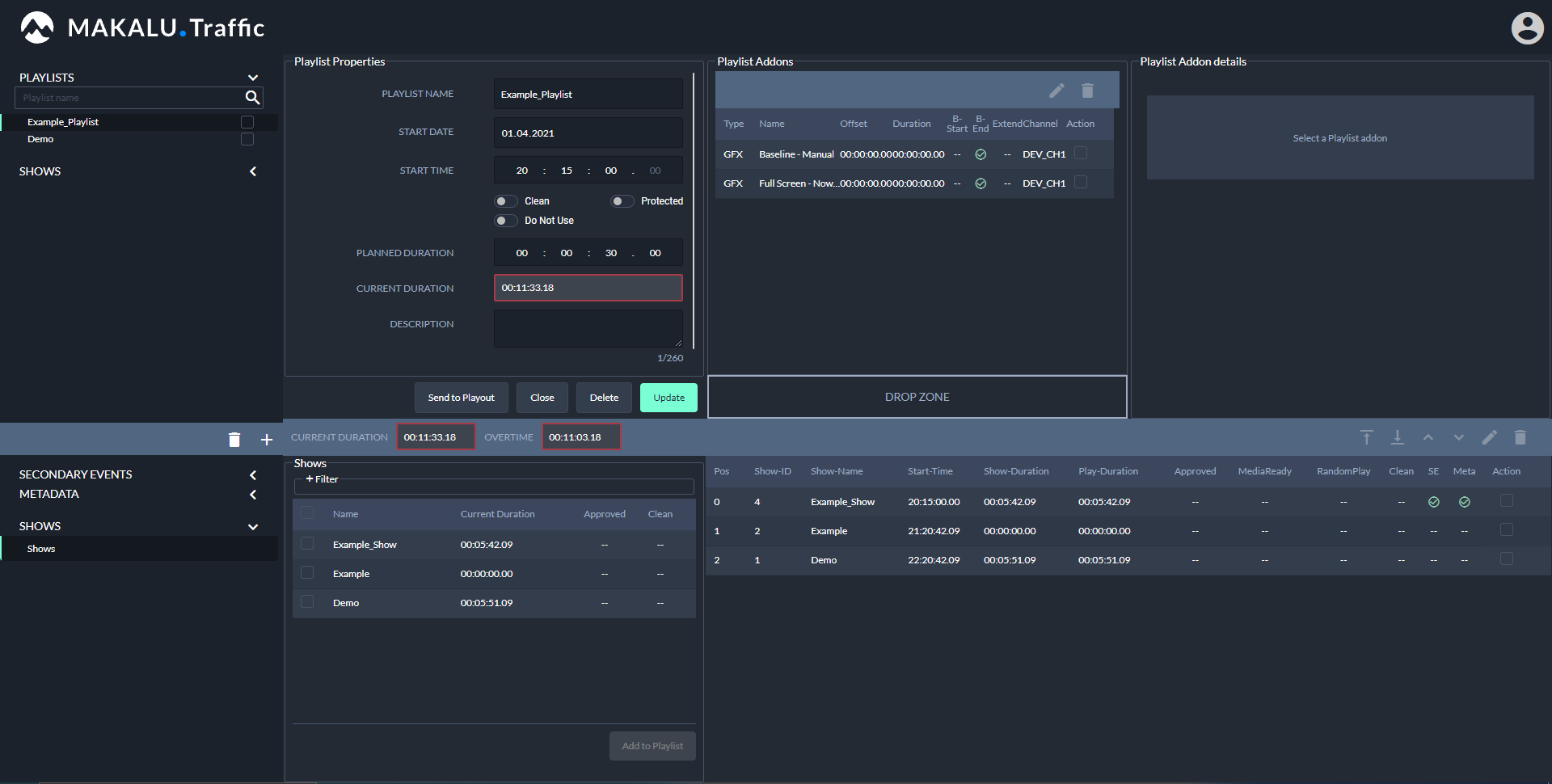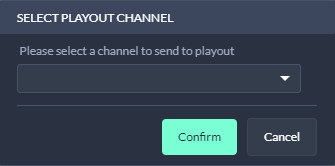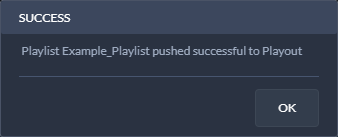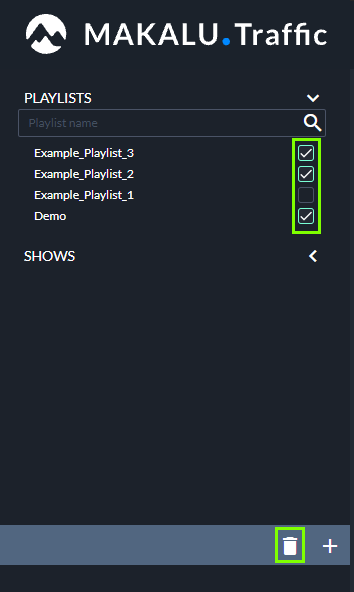Schedule¶
Makalu Traffic is the included planning/scheduling component. Its planning concept is based on playlists, shows and clips. The following table summarizes the characteristics of these and other elements that are required to understand the full planning concept:
Element | Characteristics |
|---|---|
Asset |
|
Primary event |
|
Secondary event |
|
Clip |
|
Show |
|
Playlist |
|
Rundown |
|
Accessing Makalu Traffic¶
-
Open Makalu traffic via
https://traffic.customer-identifier.makalu.live.The Makalu Traffic user interface is opened. Existing playlists and shows are displayed on the right side including properties.
Figure: Makalu Traffic user interface
Using shows¶
Creating a show¶
To create a new show, proceed as follows:
-
In the left sidebar, select Shows and click the plus icon (Add show).
Figure: Makalu Traffic - Add show
A new tab is opened for editing the show details.
Figure: Makalu Traffic - Show details
-
In the Show properties area, edit the basic show properties.
Figure: Makalu Traffic - Edited show details
-
Save the show by clicking Save below the show properties.
The show is saved, which is confirmed by a notification message. It is also added as first entry at the top of the Shows area in the left sidebar.
Notice
This step is required, otherwise you cannot add primary or secondary events to the show.
-
Add a primary event to the show.
-
In the left sidebar select Primary events and then either File, Live or Placeholder.
Depending on your selection, either files, live sources or placeholder are listed in the corresponding area to the right.
Figure: Makalu Traffic - Primary events
-
To filter the available primary events, either use the Filter search field (if you want to search for a specific file name) and/or use the dropdown menu (if you want to select a specific time period for when the file was uploaded/created).
-
Select a primary event and drag it onto the Drop Zone in the lower right area.
Notice
If you drag a file, it is directly added to the show’s clip list.
If you drag a live event, a dialog is displayed where you must set the planned duration for the event.
Figure: Makalu Traffic - Primary event added to show
The primary event is added to the show’s clip list.
Notice
The fields Current duration and Overtime are updated accordingly.
Notice
The checkmarks Sub, SE and Meta in the clip list indicate, if there are additional elements (subtitles, graphics and/or metadata) assigned to the clip.
Tip
You can also add multiple primary events at the same time, by selecting multiple elements and dragging them onto the Drop Zone in the lower right area.
-
Repeat these steps to add more primary events to the show.
The primary events are added to the show’s clip list. The start time of each added clip is calculated accordingly, depending on the duration of the previously added clips.
Tip
To delete a clip from the clip list, proceed as follows:
1 - Select one or more clips to be deleted, by activating the corresponding Action checkbox(es) in the clip list.
2 - Click the recycle bin icon (Delete Clip).
3 - In the subsequently displayed dialog, click Confirm.
-
-
(Optional) Change the order of the clip list.
-
Select one or more clips, by activating the checkbox in the Action column.
-
Use the arrow icons (move up, move down, move to top, move to bottom) above the clip list to change the order.
-
-
(Optional) Edit the clip flags.
Notice
By default, the Auto Follow flag is activated for all added primary events.
-
(Optional) Add secondary events to the show.
-
In the left sidebar select Secondary events and click on the type, e.g. Graphics.
Available secondary events of the selected type are displayed to the right.
Figure: Makalu Traffic - Secondary events
-
(Optional) To search for secondary events based on the event name, use the Filter search field.
Only secondary events are displayed that match the search term.
-
(Optional) To search for graphics based on the channel they are assigned to, select a channel in the dropdown menu right to the search field, which is by default set to All Channels.
Only graphics are displayed that are assigned to the selected channel.
Warning
If you add multiple graphics to a show, only add graphics that are all assigned to the same channel. Otherwise, you cannot send a playlist to playout that includes this show.
-
Select a secondary event and drag it onto the Drop Zone in the Show Addons area.
The secondary event is added to the show addons list.
Figure: Makalu Traffic - Secondary events added to a show
-
Repeat the previous two steps to add more secondary events to the show.
-
(Optional) Edit the properties of an added secondary event, by selecting the corresponding Action checkbox in the Show Addons area and click the Edit Addon button.
The show addon details are displayed to the right, where you can edit the available properties.
Tip
To delete an added secondary event, proceed as follows:
1 - Select one or more secondary events to be deleted, by activating the corresponding Action checkbox(es) in the Show Addons area
2 - Click the recycle bin icon (Delete Show Addons).
3 - In the subsequently displayed dialog, click Confirm.
-
-
(Optional) Add metadata to the show.
-
In the left sidebar select Metadata and click on the type, e.g. System Metadata.
Available metadata sets are displayed to the right.
Figure: Makalu Traffic - Metadata
-
To search for metadata based on the name, use the Filter search field.
-
Select a metadata set and drag it onto the Drop Zone in the Show Addons area.
The metadata set is added to the show addons list.
Figure: Makalu Traffic - Metadata added to a show
-
Repeat the previous two steps to add more metadata sets to the show.
-
(Optional) Edit the properties of an added metadata set, by selecting it in the Show Addons list and clicking the Edit Addon button.
The show addon details are displayed to the right, where you can edit the available properties.
-
-
In the Show properties area click Update.
The show is saved.
-
To close the tab with the show details, click Close below the show properties.
The tab is closed.
Editing a show¶
To edit a show, proceed as follows:
-
In the left sidebar, select Shows.
-
(Optional) To narrow the displayed shows, click on Filter and use the available options (e.g. select a content category, activate flags, or enter a name).
Figure: Makalu Traffic - Filter displayed shows
-
Click on the name of the show to be edited.
The show details are opened in a new tab.
Figure: Makalu Traffic - Show details
Notice
When a user opens a show for editing, the show is locked. Until the editing user closes the show, other users only have read access to the show.
-
Edit show properties, primary and/or secondary events as required.
-
To save your changes, click Update in the Show Properties area.
The show is saved.
-
To close the tab with the show details, click Close below the show properties.
The tab is closed.
Editing a clip¶
To edit a clip, proceed as follows:
-
In the left sidebar, select Shows and click on the name of a show.
The show details are opened in a new tab.
Figure: Makalu Traffic - Show details
-
If the clip to be edited is not in the show’s clip list, add it as described in step 8 in section Creating a show.
-
In the clip list select a clip to be edited, by activating the corresponding Action checkbox and clicking the pencil icon (Edit Clip).
Figure: Makalu Traffic - Select clip
The clip details are opened in a new tab.
Figure: Makalu Traffic - Clip details
-
Either select Secondary Events or Metadata in the sidebar on the left.
The corresponding elements are displayed to the right.
-
(Optional) Use the filter functions for name and channel to narrow down the displayed the search results.
-
Drag an element onto the Drop Zone.
The element is added to the Clip Addons list.
Figure: Makalu Traffic - Add secondary event to clip
Warning
If you add multiple graphics to a clip, only add graphics that are all assigned to the same channel. Otherwise, you cannot send a playlist to playout that includes a show with this clip.
-
To edit the element, activate the Action checkbox and click the pencil icon (Edit Addon).
The addon properties are displayed in the Clip Addon details area.
Figure: Makalu Traffic - Edit addon details
-
Change the properties.
Tip
If you are editing a graphics secondary event, you can set the time-related clip properties to default values, by clicking the set default icon (Set default values) above the clip addons list.
-
To save your changes, click Update in the Clip Addon details area.
The clip is saved.
-
To close the tab with the clip details, click Close below the clip properties.
The tab is closed.
Duplicating a show¶
To duplicate a show, proceed as follows:
-
In the left sidebar, select Shows and click on the name of the show to be duplicated.
The show details are opened in a new tab.
Figure: Makalu Traffic - Show details
-
Below the show properties click Duplicate.
A copy of the show (including all properties, primary and secondary events) is opened in a new tab.
-
Edit show properties, primary and/or secondary events as required.
-
To save your changes, click Update in the Show Properties area.
The show is saved.
-
To close the tab with the show details, click Close below the show properties.
The tab is closed.
Deleting a show¶
To delete a single show, proceed as follows:
-
In the left sidebar, select Shows and click on the name of the show to be deleted.
The show details are opened in a new tab.
Figure: Makalu Traffic - Show details
-
In the Show Properties area click Delete.
A confirmation dialog is displayed.
-
To delete the show, click Confirm.
The show is deleted.
To delete multiple shows, proceed as follows:
-
In the left sidebar, select Shows and activate the checkbox to the right of each show to be deleted.
Figure: Makalu Traffic - Shows selected for deletion
-
Click the Recycle bin icon (Delete shows).
A confirmation dialog is displayed.
-
To delete the selected shows, click Confirm.
The selected shows are deleted.
Show properties¶
The following table provides an overview of all available show properties:
Notice
Time-related properties use a frame-accurate notation in the format hh:mm:ss.ff. The frame rate time base is part of the global system configuration. Makalu supports the frame rates 25, 30, 50 and 60 fps.
| Property | Description |
|---|---|
| Show name | Name of the show |
| Category | Main content category |
| Sub-category | Content sub-category, based on the selected main content category |
| Media Ready | For future use |
| Random Play | For future use |
| Approved | For future use |
| Clean | If activated, graphics addons are not displayed when the show is played, even if graphics are assigned to the show or included clips. This also applies to cases where graphics addons of the previous show would normally extend beyond the regular end of the previous show. Depending on how the duration of the graphics addon is set, graphics of the previous show can stay displayed even after the next show starts. But if the clean flag is activated for the next show, graphics are not displayed. This is e.g. useful for a show container, that only contains commercials. |
| Planned Duration | Target duration |
| Current Duration | Actual show duration, corresponds to the total combined duration of all assigned primary events |
| Description | Text description for the show |
| Overtime | Time difference between planned duration and current duration |
Clip flags¶
Each clip within a show has a set of flags, that define how it should be played by the automation, especially how the start and end of each clip should be handled.
The following table provides an overview of all available clip flags:
Notice
Deactivated flags are displayed in grey, activated flags are highlighted in green.
Using playlists¶
Creating a new playlist¶
To create a new playlist, proceed as follows:
-
Open Makalu traffic via
https://traffic.customer-identifier.makalu.live.The Makalu Traffic user interface is opened.
Figure: Makalu Traffic user interface
-
In the left sidebar, select Playlists and click the plus icon (Add playlist).
Figure: Makalu Traffic - Add playlist
A new tab is opened for editing the playlist details.
Figure: Makalu Traffic - Playlist details
-
In the Playlist properties area, edit the basic playlist properties.
Figure: Makalu Traffic - Edit playlist properties
-
Save the playlist by clicking Save below the playlist properties.
The playlist is saved, which is confirmed by a notification message. It is also added as first entry at the top of the Playlists area in the left sidebar.
Notice
This step is required, otherwise you cannot add shows, secondary events, or metadata to the playlist.
-
Add one or more shows to the playlist.
-
In the left sidebar select Shows.
Available shows are displayed in the shows area to the right.
Figure: Makalu Traffic - Available shows
-
To search for shows based on their name or other show properties, use the Filter section.
-
Select one or more shows and click Add to playlist.
The shows are added to the playlist.
Figure: Makalu Traffic - Shows added to playlist
Notice
The fields Current duration and Overtime are updated accordingly.
Notice
In the playlist the displayed show duration corresponds to the actual duration of a show (field Current Duration in the show properties).
The start time of each added show is calculated based on the start time of the playlist (field Start Time in the playlist properties) and the duration of each added show.
The checkmarks SE and Meta indicate, if there are additional elements (graphics and/or metadata) assigned to the show.
-
(Optional) Repeat these steps to add more shows to the playlist.
Tip
To change the playlist order, proceed as follows:
1 - Select a show, by activating the corresponding Action checkbox in the playlist.
2 - Use one of the buttons Move To Top, Move To Bottom, Move Up or Move Down to move the show to the new position.
Tip
To open and edit a show directly from the playlist, proceed as follows:
1 - Select a show, by activating the corresponding Action checkbox in the playlist.
2 - Click the pencil icon (Edit show).
The show is opened in a new tab.
Tip
To delete an added show, proceed as follows:
1 - Select one or more shows to be deleted, by activating the corresponding Action checkbox(es) in the playlist.
2 - Click the recycle bin icon (Delete Show).
3 - In the subsequently displayed dialog, click Confirm.
-
-
(Optional) Add secondary events to the playlist.
-
In the left sidebar select Secondary events and click on the type, e.g. Graphics.
Available secondary events of the selected type are displayed to the right.
Figure: Makalu Traffic - Secondary events
-
(Optional) To search for secondary events based on the event name, use the Filter search field.
Only secondary events are displayed that match the search term.
-
(Optional) To search for graphics based on the channel they are assigned to, select a channel in the dropdown menu right to the search field, which is by default set to All Channels.
Only graphics are displayed that are assigned to the selected channel.
Warning
If you add multiple graphics to a playlist, only add graphics that are all assigned to the same channel. Otherwise, you cannot send the playlist to playout.
-
Select a secondary event and drag it onto the Drop Zone in the Playlist Addons area.
The secondary event is added to the playlist addons.
Figure: Makalu Traffic - Secondary events added to playlist
-
Repeat these steps to add more secondary events to the playlist.
-
(Optional) Edit the properties of an added secondary event, by selecting it in the Playlist Addons list and clicking the Edit Playlist Addons button.
The playlist addon details are displayed to the right, where you can edit the available properties and save by clicking Update.
Tip
To delete an added secondary event, proceed as follows:
1 - Select one or more secondary events to be deleted, by activating the corresponding Action checkbox(es) in the Playlist Addons area
2 - Click the recycle bin icon (Delete Playlist Addons).
3 - In the subsequently displayed dialog, click Confirm.
-
-
In the Playlist properties area click Update.
The playlist is saved.
-
To close the tab with the playlist details, click Close below the playlist properties.
The tab is closed.
Sending a playlist to playout¶
To make a playlist available for a playout channel in the Makalu Automation, the Send to Playout function must be used.
If a playlist is sent to playout, it is by default added to the rundown of the selected channel using the start date and time that are set in the playlist properties.
Notice
If the rundown of the selected channel already contains a different playlist at the selected date and time, the playlist cannot be sent to playout.
To send a playlist to playout, proceed as follows:
-
Open Makalu Traffic.
-
In the left sidebar, select Playlists and click on the name of the playlist that you want to send to playout.
The playlist details are opened in a new tab.
Figure: Makalu Traffic - Playlist details
Notice
A playlist can only be sent to playout if all included shows are approved. Otherwise, the Send to playout function is not available.
-
Click Send to Playout.
The select playout channel dialog is displayed.
Figure: Makalu Traffic - Select playout channel
-
Select the playout channel that you want to send the playlist to.
Warning
All graphics that you added to clips, shows and/or the playlist must be assigned to the selected channel. If you use graphics in the playlist that are assigned to a channel other than the selected, you cannot send the playlist to playout. In this case a corresponding error message is displayed after the next step.
-
Click Confirm.
The playlist is made available for the selected channel in the Makalu Automation.
Figure: Makalu Traffic - Successful send to playout
Notice
If you edit a playlist, that was already sent to playout and you use Send to playout again, the existing playlist is updated and can be used for the corresponding playout channel.
Editing a playlist¶
To edit a playlist, proceed as follows:
-
Open Makalu Traffic.
-
In the left sidebar, select Playlists and click on the name of the playlist to be edited.
The playlist details are opened in a new tab.
Figure: Makalu Traffic - Playlist details
-
Edit playlist properties, primary events, secondary events and/or metadata as required.
-
In the Playlist Properties area click Update.
The playlist is saved.
Deleting a playlist¶
To delete a single playlist, proceed as follows:
-
Open Makalu Traffic.
-
In the left sidebar, select Playlists and click on the name of the playlist to be deleted.
The playlist details are opened in a new tab.
Figure: Makalu Traffic - Playlist details
-
In the Playlist Properties area click Delete.
A confirmation dialog is displayed.
-
To delete the playlist, click Confirm.
The playlist is deleted.
To delete multiple playlists, proceed as follows:
-
Open Makalu Traffic.
-
In the left sidebar, select Playlists and activate the checkbox to the right of each playlist to be deleted.
Figure: Makalu Traffic - Playlists selected for deletion
-
Click the Recycle bin icon (Delete playlists).
A confirmation dialog is displayed.
-
To delete the selected playlists, click Confirm.
The selected playlists are deleted.
Playlist properties¶
The following table provides an overview of all available playlist properties:
Notice
Time-related properties use a frame-accurate notation in the format hh:mm:ss.ff. The frame rate time base is part of the global system configuration. Makalu supports the frame rates 25, 30, 50 and 60 fps.
| Property | Description |
|---|---|
| Playlist Name | Name of the playlist |
| Start Date | Planned on air date |
| Start Time | Planned airtime |
| Planned Duration | Planned target duration |
| Clean | If activated, graphics addons are not displayed when the playlist is played, even if graphics are assigned to the playlist or to included shows or clips. This also applies to cases where graphics addons of the previous playlist would normally extend beyond the regular end of the previous playlist. Depending on how the duration of the graphics addon is set, graphics of the previous playlist can stay displayed even after the next playlist starts. But if the clean flag is activated for the next playlist, graphics are not displayed. This is e.g. useful for a playlist, that only contains shows that consist exclusively of commercials. |
| Protected | If activated and automatic rundown mode is enabled, the playlist cannot be deleted automatically from the rundown (see section Rundown modes for more information). This is useful if you use automatic rundown mode and always want to keep a playlist in the rundown e.g. for emergency situations. |
| Do not use | If activated and automatic rundown mode is enabled, the playlist is not automatically added to the rundown (see section Rundown modes for more information). |
| Current Duration | Actual playlist duration, corresponds to the total combined duration of all assigned shows |
| Description | Text description for the playlist |
Secondary events¶
When a secondary event is added to a clip, show or playlist, it is considered as an “addon”. Each addon has common time-related properties and optional content-related properties, that apply and can be edited within the context of the corresponding clip, show or playlist.
Notice
Time-related properties use a frame-accurate notation in the format hh:mm:ss.ff. The frame rate time base is part of the global system configuration. Makalu supports the frame rates 25, 30, 50 and 60 fps.
Common properties¶
The following common and time-related properties are used by graphics and metadata secondary events:
| Property | Description |
|---|---|
| Addon name | Name of the addon |
| Start offset | Offset until the addon is displayed (based on the start of the clip, show or playlist) |
| Bind start offset to end | If activated, the start offset will be calculated based on the start of the clip, show or playlist |
| End offset | Offset until the addon is removed (based on the end of the clip, show or playlist) |
| Bind end offset to end | If activated, the end offset will be calculated based on the end of the clip, show or playlist |
| Extend | If activated, the display duration of the addon can be extended beyond the regular end of the clip, show or playlist it is assigned to. |
Graphics properties¶
The following table provides an overview of available graphics secondary event properties:
| Property | Description |
|---|---|
| Addon sub-type | Graphics sub type (e.g. Singular) |
| Use payload | If activated, a custom payload text can be entered. If deactivated, the default payload configured in Singular.Live is used instead. Input fields for custom payload text are only available for graphics that include dynamic text. |
| Graphics type-specific properties | Depending on the graphics type different properties are displayed (e.g. scale and position for images or input fields for the dynamic text payloads) |
Examples for using time-related properties¶
The following table provides examples for using time-related addon properties:
| Example | Start offset | Duration / end offset | Bind end offset to end |
|---|---|---|---|
| Display a graphics addon for the entire duration of a clip, show or playlist | 00:00:00:00 | 00:00:00:00 | Deactivated |
| Display a graphics addon 5 seconds after the clip, show or playlist starts and remove it 10 seconds later | 00:00:05:00 | 00:00:10:00 | Deactivated |
| Display a graphics addon 20 seconds before the clip, show or playlist ends and remove it 15 seconds later | 00:00:20:00 | 00:00:15:00 | Activated |
| Display a graphics addon 2 seconds before the clip, show or playlist ends and remove it 4 seconds later In this case the addon would overlap two clips, shows or playlists. which is e.g. useful for displaying transition effects (wipe, fade, etc.). | 00:00:02:00 | 00:00:04:00 | Activated |
Splicing properties¶
Notice
Splicing events are part of the Dynamic ad triggering (SCTE-35) feature that is available as optional Makalu addon. For more information see section Ad triggering.
The following table provides an overview of available splicing secondary event properties:
| Property | Description |
|---|---|
| Event offset | Offset for the start time of the splicing event (if set to 00:00:00:00 the splicing event trigger is sent starting with the first I-Frame of the corresponding clip or show the event is assigned to) |
| Send duration | If activated, the splicing event duration is also included in the splicing event trigger |
| Splicing event id | Splicing event id (allows a downstream system to decide how the original content should be replaced or blanked) |
| UPID type | Splicing event type UPID (allows a downstream system to decide how the original content should be replaced or blanked) |
| UPID | Splicing event UPID (allows a downstream system to decide how the original content should be replaced or blanked) |
| Web delivery allowed | If activated, the "web delivery allowed" flag is set accordingly in the splicing event trigger, signaling a downstream system that web delivery is allowed for the corresponding content |
| Regional blackout | If activated, the "regional blackout" flag is set accordingly in the splicing event trigger, signaling a downstream system that regional blackout is enabled for the corresponding content |
| Archive allowed | If activated, the splicing event trigger includes information that signals a downstream system that archiving is allowed for the corresponding content |
| Device restrictions | Information about restrictions that apply to certain device groups |
| Use automatic | If activated, the end splicing event trigger is sent automatically when the event duration is completed If deactivated, the end splicing event trigger must be sent manually by the operator |
| Avail expected | Total number of avails to be expected Range: 0-255 (use 0 to disable feature) Only available for splicing secondary events of type "SCTE-35 Avail" |
| Avail num | Current avail number Range: 0-255 (use 0 to disable feature, must not be greater than "Avail expected" number) Only available for splicing secondary events of type "SCTE-35 Avail" |
| Auto return | Defines if downstream systems should automatically switch back to the original program content at the end of an avail If activated, downstream systems get the information to automatically switch back to the original program content when the avail duration ends (requires that "Send duration" is also activated) If deactivated, downstream systems get the information to not automatically switch back to the original program content. Instead they must wait until they receive the corresponding message, which is automatically sent by the splicer and triggers downstream systems to switch back to the original program content. Only available for splicing secondary events of type "SCTE-35 Avail" |
Stream target properties¶
The following table provides an overview of available stream target secondary event properties:
| Type | Property | Description |
|---|---|---|
| YouTube | Title | Stream event title |
| YouTube | Description | Stream event content description |
| YouTube | Automatic | Time-related switch |
| YouTube | Start time | Start date and time of the streaming event |
| Generic | Source stream | Source to be streamed |
| Generic | Target type | Target type of the stream (e.g. YouTube, Facebook, LinkedIn, Twitch, RTMP, RTMPS) |
| Generic | Title | Stream event title |
| Generic | Description | Stream event content description |
| Generic | Stream URL | Target URL |
| Generic | Stream key | Stream key (used for authentication) |
| Generic | Username | Username (if required for authentication) |
| Generic | Password | Password (if required for authentication) |
| Generic | Start time | Start date and time of the streaming event |
Recording properties¶
The following table provides an overview of available recording secondary event properties:
| Property | Description |
|---|---|
| Source stream | Source stream to be recorded |
| Record channel | Encoder to be used for the recording |
| Job name | Name of the recording job |
| Dest path | Target folder for storing the recorded file |
| Profile | File format/profile to be used for the recording (only available if a broadcast encoder is used) |
Metadata properties¶
The following table provides an overview of available metadata secondary event properties:
| Type | Property | Description |
|---|---|---|
| EPG | Short event descriptor | Short description of the content |
| EPG | Extended event descriptor | Detailed description of the content |
| EPG | Name | EPG name |
| EPG | FSK | Parental rating (based on German motion picture rating system organization FSK, e.g. 0, 6, 12, 16, 18) |
| EPG | DVB content | Content category (e.g. news, magazine, comedy, etc.) |
| EPG | Char code | Character encoding of the EPG information (default: Western European - ISO/IEC 8859) |
| EPG | Language | Language of the EPG information (e.g. German or English) |
| Moderator | Name | Moderator name |
| Now Next Later | Now | Now text |
| Now Next Later | Next | Next text |
| Now Next Later | Later | Later text |
| Online EPG | Title | Online EPG title |
| Online EPG | Short synopsis | Short content summary |
| Online EPG | Detail synopsis | Detailed content summary |

